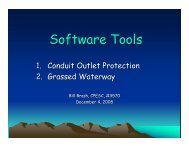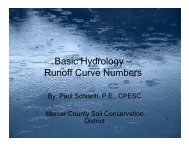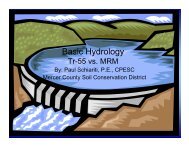Basic Hydrology Time of Concentration Methodology
Basic Hydrology Time of Concentration Methodology
Basic Hydrology Time of Concentration Methodology
You also want an ePaper? Increase the reach of your titles
YUMPU automatically turns print PDFs into web optimized ePapers that Google loves.
<strong>Basic</strong> <strong>Hydrology</strong><br />
<strong>Time</strong> <strong>of</strong> <strong>Concentration</strong><br />
<strong>Methodology</strong><br />
By: Paul Schiariti, P.E., CPESC<br />
Mercer County Soil Conservation<br />
District
What is the <strong>Time</strong> <strong>of</strong> <strong>Concentration</strong>?<br />
The time it takes for run<strong>of</strong>f to travel from the most<br />
hydraulically distant point in the watershed to a<br />
point <strong>of</strong> interest.<br />
What is the most Hydraulically Distant Point in the<br />
watershed?<br />
Is it a “hydraulic distance” or a “hydraulic time”?<br />
Is there a difference?
Hydraulically Most Distant Point?<br />
Path “A” is 1000 ft. long with a <strong>Time</strong> <strong>of</strong> <strong>Concentration</strong> = 1.00 Hours<br />
Path “B” is 750 ft. long with a <strong>Time</strong> <strong>of</strong> <strong>Concentration</strong> = 1.25 Hours
Where is the “Correct TC Flow Path?
What is the difference in T C for both Flow Paths?<br />
Path “B” T C = 0.39 Hours, Path “A” T C = 0.20 Hours
What is the difference in Q PEAK for the two Flow<br />
Paths & which is correct?<br />
Approximately 9 Acres <strong>of</strong> the 10<br />
Acres flows similar to Path “B”,<br />
therefore this path is<br />
representative <strong>of</strong> 90% <strong>of</strong> the<br />
drainage area, and realistically<br />
better represents the watershed<br />
The use <strong>of</strong> T C Flow Path<br />
“B” represents an underestimation<br />
<strong>of</strong> Q PEAK by 19<br />
to 20%.<br />
Would this be an issue if<br />
it was the Pre-<br />
Development analysis?
Three Components <strong>of</strong> the Segmental <strong>Time</strong> <strong>of</strong><br />
<strong>Concentration</strong> Method<br />
1. Sheet Flow: “Sheet flow is flow over plane surfaces. It<br />
usually occurs in the headwater <strong>of</strong> streams.”<br />
The most sensitive component <strong>of</strong> the T C . Pay very close<br />
attention to the Manning’s Roughness Coefficient. Pay very<br />
close attention to the ground surface slope. The maximum<br />
sheet flow length should be no greater than 125 to 150 ft.<br />
2. Shallow Concentrated Flow: “After a maximum <strong>of</strong> 300 feet,<br />
sheet flow usually becomes shallow concentrated flow.”<br />
Note: This 300 ft. value has since been revised down to a<br />
maximum <strong>of</strong> 150 ft. on very uniform surfaces. The latest<br />
version <strong>of</strong> WinTR-55 only allows up to 100 ft. <strong>of</strong> sheet flow.<br />
3. Channel Flow: Channel flow occurs within swales,<br />
channels, streams, ditches and piped storm drainage<br />
systems. Velocities are computed for channel flow based<br />
upon Manning’s open channel flow equation.
TR-55 Segmental <strong>Time</strong> <strong>of</strong> <strong>Concentration</strong><br />
Sheet Flow Travel <strong>Time</strong> Component<br />
P 2 values are obtained from NRCS 24<br />
Hour Design Storm Rainfall Depths.
TR-55 Segmental <strong>Time</strong> <strong>of</strong> <strong>Concentration</strong><br />
Shallow Concentrated Flow and Channel Flow Component
How sensitive is the Sheet Flow equation to Manning’s “n”?<br />
Sheet Flow Equation:<br />
T T= (.007) x (n) 0.8 x (L) 0.8<br />
P 2 0.5 x S 0.4<br />
• Example: L = 125 ft.<br />
P 2 = 3.00 In.<br />
S = 0.006 ft / ft<br />
Lets say an “n” value <strong>of</strong> 0.05 was mistakenly used when an “n” value <strong>of</strong><br />
0.24 was the appropriate value. What effect will this have on the <strong>Time</strong> <strong>of</strong><br />
<strong>Concentration</strong>? What effect will this have on the peak discharge rates?<br />
“n” = 0.05: T T= (.007) x (0.05) 0.8 x (125) 0.8 = 0.136 Hours (Incorrect)<br />
3.0 0.5 x 0.006 0.4<br />
“n” = 0.24: T T= (.007) x (0.24) 0.8 x (125) 0.8 = 0.475 Hours (Correct)<br />
3.0 0.5 x 0.006 0.4<br />
This represents an under-estimation <strong>of</strong> the <strong>Time</strong> <strong>of</strong> <strong>Concentration</strong> <strong>of</strong> 71%!!!
How does this effect the peak Discharge?<br />
Drainage Area = 20.00 Acres<br />
Run<strong>of</strong>f Curve Number = 74<br />
10 Year Storm Precipitation = 5.00 Inches<br />
Additional Travel <strong>Time</strong> for Shallow Concentrated Flow Plus<br />
Channel Flow = 0.50 Hours<br />
T C1 = 0.136 Hours + 0.40 Hours = 0.536 Hours<br />
T C2 = 0.475 Hours + 0.40 Hours = 0.875 Hours<br />
Q 0.05 = 30.70 cfs (Incorrect)<br />
Q 0.24 = 24.10 cfs (Correct)<br />
Difference in Peak Discharge Rates = 6.60 cfs<br />
Over estimates the peak discharge by 27.4% !!
Effect on the Run<strong>of</strong>f Hydrograph for the different T C ’s<br />
But the timing <strong>of</strong> the Peak Discharge is<br />
different as well.<br />
Not only is the actual<br />
Peak Discharge<br />
different…
A<br />
What is the correct Manning’s n value?<br />
B<br />
Manning’s “n” for “Maintained Turf Grass” should almost<br />
always be = 0.24
Percent Increase In The Sheet Flow Travel <strong>Time</strong> Related to<br />
Change In Ground Slope<br />
% Decrease In Sheet Flow Tt<br />
0.0<br />
10.0<br />
20.0<br />
30.0<br />
40.0<br />
50.0<br />
60.0<br />
0.50<br />
0.60<br />
0.70<br />
25 %<br />
0.80<br />
0.90<br />
1.00<br />
Ground Slope In %<br />
1.10<br />
An over-estimation <strong>of</strong> ground slope from 1.00 % to 2.00 %<br />
results in an under-estimation in the Sheet Flow<br />
component <strong>of</strong> the <strong>Time</strong> <strong>of</strong> <strong>Concentration</strong> by 25 %.<br />
1.20<br />
1.30<br />
1.40<br />
1.50<br />
1.60<br />
1.70<br />
1.80<br />
1.90<br />
2.00
93<br />
92<br />
Example <strong>Time</strong> <strong>of</strong> <strong>Concentration</strong> Calculation<br />
92<br />
93<br />
94<br />
95<br />
96<br />
X<br />
"D"-<br />
93.3<br />
Channel Flow<br />
Shallow<br />
Concentrated<br />
Flow Sheet Flow<br />
250 ft. 125 ft. 100 ft.<br />
93 92 92 93 94 95 96 97 98 99<br />
97<br />
98<br />
X<br />
"C"-<br />
96.0<br />
99<br />
100<br />
X<br />
"B"-<br />
99.5<br />
X<br />
"A"-<br />
100.5<br />
Note: The individual segment lengths are not the<br />
horizontal distances, but the linear distances along the<br />
flow path line.
1. Compute the Sheet Flow<br />
Travel <strong>Time</strong> Component <strong>of</strong><br />
the <strong>Time</strong> <strong>of</strong> <strong>Concentration</strong>:<br />
“B” –<br />
99.5<br />
Example - Continued<br />
“A” –<br />
100.5<br />
What surface description best categorizes this type <strong>of</strong> ground<br />
cover for the purpose <strong>of</strong> choosing a Manning’s “n” Roughness<br />
Coefficient ?<br />
100<br />
X<br />
"B"-<br />
99.5<br />
Sheet Flow<br />
100 ft.<br />
99<br />
X<br />
"A"-<br />
100.5
Which Manning’s “n” value most closely mimics this<br />
specific ground cover?<br />
We can immediately eliminate the<br />
following:<br />
Smooth Surfaces<br />
Fallow (No Residue)<br />
Cultivated Soil<br />
Woods<br />
This leaves the following choices:<br />
Grass<br />
Range<br />
Range is defined as: “An extensive tract<br />
<strong>of</strong> open land on which livestock wander<br />
and graze.”<br />
This is not a range !<br />
This leaves us with the grass options:<br />
Best fit is Dense Grasses – “n” = 0.24
Compute the Sheet Flow Travel <strong>Time</strong> Component:<br />
Sheet Flow Equation:<br />
T T = (.007) x (n) 0.8 x (L) 0.8<br />
P 2 0.5 x S 0.4<br />
L = 100 ft.<br />
P2 = 3.00 In.<br />
S = (100.5 – 99.5)/ 100 = 0.01 ft / ft<br />
n = 0.24<br />
T T = (.007) x (0.24) 0.8 x (100) 0.8 = 0.324 Hrs<br />
3.0 0.5 x 0.010 0.4<br />
• The next component <strong>of</strong> the <strong>Time</strong> <strong>of</strong> <strong>Concentration</strong> is the shallow<br />
Concentrated flow Travel <strong>Time</strong> portion.
Shallow Concentrated Flow Component <strong>of</strong> the <strong>Time</strong> <strong>of</strong><br />
<strong>Concentration</strong><br />
“C” –<br />
96.0<br />
“B” –<br />
99.5<br />
S hallow<br />
Concentrated<br />
Flow S<br />
125 ft.<br />
X<br />
"C"-<br />
96.0<br />
99<br />
100<br />
X<br />
"B"-<br />
99.5<br />
97 98 9<br />
Shallow Concentrated Flow is 125 ft. (non-paved) at (99.5-96.0)<br />
/125 = 0.028 ft/ft
0.028<br />
ft/ft<br />
Enter Figure 3-1 to arrive at the Average Velocity<br />
2.7 fps<br />
T T = 125 / 3600 x 2.70 = 0.013 hrs.<br />
The actual equation used to<br />
determine the velocity for Shallow<br />
Concentrated flow is based on:<br />
T T = L * (58,084.2 * s 0.5 ) -1<br />
-or-<br />
T T = L<br />
3600 x 16.1345 x S 0.5<br />
Therefore: V = 16.1345 x S 0.5
Channel Flow Component <strong>of</strong> the <strong>Time</strong> <strong>of</strong> <strong>Concentration</strong><br />
“D” –<br />
93.3<br />
“C” –<br />
96.0<br />
5<br />
96<br />
X<br />
"D"-<br />
93.3<br />
Channel Flow<br />
250 ft.<br />
97<br />
98<br />
Con<br />
X<br />
"C"-<br />
96.0<br />
95 96 97<br />
The Channel Slope is 250 ft. at (96.0-93.3)/250 = 0.0108 ft/ft<br />
Note: The channel does not have to possess a visible water surface to be<br />
considered channel flow.
Solve Manning’s equation to arrive at the Channel Velocity<br />
1.5 ft<br />
5 ft<br />
Approximate channel geometry<br />
2<br />
1<br />
Wow ! There are several<br />
unknown variables here. How<br />
are we going to assign values to<br />
them ?<br />
The first thing we need to know<br />
is the channel cross sectional<br />
geometry.<br />
Assume a reasonable flow<br />
depth – say 1.5 ft, and solve for<br />
the cross sectional flow area<br />
and the wetted perimeter.
The first step is to compute the Hydraulic Radius:<br />
Compute the Hydraulic Radius as follows:<br />
1.5 ft<br />
5 ft<br />
The Hydraulic Radius is equal to the cross – sectional flow area divided by the<br />
wetted perimeter:<br />
A = (5.0 ft. x 1.5 ft.) + [(1.5 ft. x 2) x 1.5 ft.] = 12.0 s.f.<br />
WP = 5.0 ft. + [2 x (3.0 ft. 2 + 1.5 ft. 2 ) 1/2 ] = 18.42 ft.<br />
R = 12.0 s.f. / 18.42 ft. = 0.651 ft.<br />
How do we compute the Manning’s “n” roughness coefficient?<br />
2<br />
1
Method used to determine Manning’s n value for earthen channels<br />
(Not to be confused with Manning’s “n” for Sheet Flow)<br />
SUPPLEMENT A contained within Appendix A8 <strong>of</strong> the NJ STANDARDS entitled<br />
“Method for Estimating Manning’s “n”” contains a practical methodology based upon<br />
“Cowan's Equation”:<br />
n =(n 0 + n 1 + n 2 + n 3 + n 4 ) x m 5<br />
Where:<br />
n = Manning’s “n” value<br />
n 0 = the portion <strong>of</strong> the n value that represents the channel material in a straight,<br />
uniform smooth reach<br />
n 1 = the additional value added to correct for the effect <strong>of</strong> channel surface<br />
irregularities<br />
n 2 = the additional value for variations in shape and size <strong>of</strong> the channel cross section<br />
through the reach<br />
n 3 = the additional value for obstructions (such as beaver dams, debris dams,<br />
stumps, downed trees, and root wads extending into the channel)<br />
n 4 = the additional value for vegetation in the channel<br />
m 5 = the correction factor for the meandering <strong>of</strong> the channel
Manning’s “n” values to be used for Cowan’s method for channel<br />
roughness<br />
Material Involved<br />
Degree <strong>of</strong> Irregularity<br />
Vegetation<br />
Degree <strong>of</strong> Meandering<br />
Channel Conditions<br />
Variations <strong>of</strong> Channel Cross Section<br />
Relative Effect <strong>of</strong> Obstructions<br />
Earth<br />
Rock cut<br />
Fine gravel<br />
Coarse gravel<br />
Smooth<br />
Minor<br />
Moderate<br />
Severe<br />
Gradual<br />
Alternating occasionally<br />
Alternating frequently<br />
Negligible<br />
Minor<br />
Appreciable<br />
Severe<br />
Low<br />
Medium<br />
High<br />
Very high<br />
Minor<br />
Appreciable<br />
Severe<br />
n 0<br />
n 1<br />
n 2<br />
n 3<br />
n 4<br />
m 5<br />
Values<br />
0.02<br />
0.025<br />
0.024<br />
0.028<br />
0<br />
0.005<br />
0.01<br />
0.02<br />
0<br />
0.005<br />
0.010-0.015<br />
0<br />
0.010-0.015<br />
0.020-0.030<br />
0.040-0.060<br />
0.005-0.010<br />
0.010-0.025<br />
0.025-0.050<br />
0.050-0.100<br />
1<br />
1.15<br />
1.3
Compute Manning’s “n” value for the channel<br />
n0 = Earth Channel = 0.02<br />
n1 = Smooth Irregularity = 0.00<br />
n2 = Gradual Section Variations = 0.00<br />
n3 = Negligible Obstructions = 0.00<br />
n4 = Low to Medium Vegetation = 0.01<br />
0.03<br />
m5 = Minor Meandering = 1.00<br />
Manning’s “n” value = 0.03 x 1.00 = 0.03
Compute the Travel <strong>Time</strong> for the channel section<br />
V = 1.486 x R 2/3 x S ½<br />
n<br />
V = 1.486 x 0.651 2/3 x 0.0108 ½ = 3.87 fps<br />
0.03<br />
TT = 250 / 3600 x 3.87 = 0.0179 hours<br />
The total <strong>Time</strong> <strong>of</strong> <strong>Concentration</strong> = T T1 + T T2 + T T3 = T C<br />
TC = 0.324 Hr. + 0.013 Hr. + 0.018 Hr. = 0.355 Hr.
What if our depth <strong>of</strong> flow assumption was incorrect?<br />
Lets say the actual flow depth was 0.5 ft. as opposed to our original<br />
assumption <strong>of</strong> 1.5 ft:<br />
0.5 ft<br />
5 ft<br />
A = (5.0 ft. x 0.5 ft.) + [(0.5 ft. x 2) x 0.5 ft.] = 3.00 s.f.<br />
WP = 5.0 ft. + [2 x (1.0 ft. 2 + 0.5 ft. 2 ) 1/2 ] = 7.24ft.<br />
R = 12.0 s.f. / 18.42 ft. = 0.414 ft.<br />
V = 1.486 x 0.414 2/3 x 0.0108 ½ = 2.86 fps<br />
0.03<br />
T T = 250 / 3600 x 2.86 = 0.024 hours<br />
Remember our original TT was 0.018 hours!!<br />
Really, not that much <strong>of</strong> a difference.<br />
2<br />
1
What is the correct Manning’s “n” value for Sheet Flow ?<br />
Is this Fallow (no residue) or<br />
Cultivated Soils: Residue Cover <<br />
20%; n = 0.05 or 0.06 ?
What is the correct Manning’s “n” value for Sheet Flow ?<br />
Cultivated Soils: Residue Cover ><br />
20%; n = 0.17
What is the correct Manning’s “n” value for Sheet Flow ?<br />
Smooth Surface (concrete, asphalt,<br />
gravel or bare soil); n = 0.011
What is the correct Manning’s “n” value for Sheet Flow ?<br />
Woods; Light Underbrush;<br />
n = 0.40
Summary:<br />
1. Make sure the flow path is representative <strong>of</strong><br />
the drainage area.<br />
2. Check the Manning’s “n” value in the sheet<br />
flow equation.<br />
3. Check the slope used in the sheet flow<br />
equation.<br />
4. Do the field conditions agree with the<br />
analysis?<br />
5. If the Tc goes up from the pre-development to<br />
the post-development, there may be an error.<br />
6. Tc should typically go down from pre to postdevelopment.
Questions and (hopefully!) Answers ?





